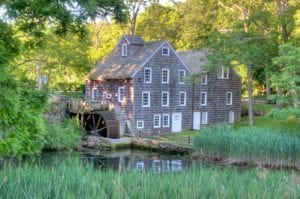Thursday April 18
Art Reception at the Atelier
The Atelier at Flowerfield, 2 Flowerfield, Suite 6 & 9, St. James invites the community to an opening reception for “Not Just Another Pretty Flower 3,” a vivid exhibition by artist Mary Ahern from 5:30 to 7:30 p.m. The show will be on view through May 30. For more information, call 631-250-9009.
Audubon Spring Lecture
Four Harbors Audubon Society hosts a Spring lecture via Zoom titled Wild Stories from the History of Migration at 7 p.m. Guest speaker Rebecca Heisman will share some surprising stories of bird migration and will discuss why understanding migration is crucial for bird conservation. Registration is required. Email [email protected] for more information.
Vanderbilt Lecture
Suffolk County Vanderbilt Museum, 180 Little Neck Road, Centerport continues its lecture series at the Charles and Helen Reichert Planetarium will a presentation by Rachel and Timothy Miller on Restoring Historic Ironworks, with a focus on Samuel Yellin, from 7 to 8:30 pm. Tickets are $10, members free, at www.vanderbiltmuseum.org.
Pine Barrens Lecture
Walt Whitman Birthplace State Historic Site, 146 Old Walt Whitman Road, Huntington Station presents a lecture titled The Pine Barrens: Who’s Guarding Our Long Island Treasure? from 7 to 8:30 p.m. LI Pine Barrens board member Tom Casey will speak about the importance of the Pine Barrens. WWBA Trustee Mark Nuccio will read Whitman’s ecopoetry and essays. Singer-Songwriter Linda Sussman performs a musical environmental interlude. Everyone in attendance may enter into a lottery to win one of 15 fir trees that were donated by New York State Parks. Free admission. For more information, visit www.waltwhitman.org.
Friday April 19
Friday Food Truck Fest
Three Village Historical Society, 93 North County Road, Setauket hosts a Friday Food Truck Fest tonight and April 26 from 4 to 7 p.m. Grab a delicious dinner, pull up a picnic table, and hang out with friends and neighbors. The historic house will be open for free tours during the event. 631-751-3730
CSHL Classical Concert
Cold Spring Harbor Laboratory’s Grace Auditorium 1 Bungtown Road, Cold Spring Harbor welcomes pianists Stephanie Ho and Saar Ahuvia in concert from 6 to 7 p.m. The performance will feature pieces by Fanny Hensel Mendelssohn,Ludwig van Beethoven,Maurice Ravel, Dmitri Shostakovich, and Manuel de Falla. A reception will follow. Tickets are $23.18 at www.cshl.edu, free for CSHL faculty, students, and staff.
Third Friday at the Reboli
The Reboli Center for Art and History, 64 Main St., Stony Brook presents an illustrated lecture titled Art of Social Justice: Cautionary Images of Optimism with artist, curator and educator Marc Fasanella from 6:30 to 8 p.m. Free. No reservations required. Light refreshments will be served. 631-751-7707
An Evening of Jazz
The Jazz Loft, 275 Christian Ave., Stony Brook welcomes globally recognized saxophonist Dayna Sean Stephens and his quartet in concert at 7 p.m. Tickets are $30 adults, $25 seniors, $20 students, $15 children ages 5 and up. To order, call 631-751-1895 or visit www.thejazzloft.org.
Hawaiian/Polynesian Heritage Night
The Leo P. Ostebo Kings Park Heritage Museum, RJO Intermediate School, 1 Church St., Kings Park presents a Hawaiian/Polynesian Heritage Night featuring the tropical entertainment of Ohana Mokuloa & Friends at 7 p.m. Doors open at 6 p.m. Free admission. www.kpheritagemuseum.net
Saturday April 20
Antiques in April
Join the Huntington Historical Society for an outdoor antiques sale on the grounds of the Kissam House property, 434 Park Ave., Huntington today and April 21 from 10 a.m. to 4 p.m. featuring antiques dealers on the lawn; books, antiques and furniture in the barn; and specials from their Antiques & Collectibles Shop. Free admission. Held rain or shine. Questions? Call 631-427-7045.
Fling Into Spring Carnival
Newton Shows partners with the North Shore Youth Council (NSYC) to present its 9th annual Fling into Spring community carnival at Heritage Park , 633 Mount Sinai-Coram Road, Mt. Sinai today from 11 a.m. to 10:30 p.m and April 21 from 11 a.m. to 7 p.m. Enjoy a weekend of carnival rides, games, nostalgic eats, children’s magic and illusion shows, laughter, and fun for the whole family with free parking and free admission. Advance tickets, including pay-one-price bracelets, can be purchased at newtonshows.com.
Spring Appreciation Day
The Ward Melville Heritage Organization’s Spring Appreciation Day returns to the Stony Brook Village Center, 111 Main St., Stony Brook with a Mustang and Shelby Club of Long Island car show from 11 a.m. to 3 p.m., a petting zoo, scavenger hunt and live music by Brenda and Burke from 1:30 to 3:30 p.m.; a visit from the Stony Brook fire department; and tours of the Stony Brook Grist Mill from noon to 4 p.m. For more information, call 631-751-2244 or visit www.wmho.org.
The Trocks head to SBU
Les Ballets Trockadero de Monte Carlo, the world’s foremost all-male ballet company, heads to Stony Brook University’s Staller Center’s Main Stage, 100 Nicolls Road, Stony Brook at 8 p.m. Parodying the conventions of romantic and classical ballet, the troupe has been entertaining audiences since its founding in 1974 with its signature comedic style. Look no further for top-notch ballet that’s also uproariously funny! Tickets range from $46 to $65. To order, call 631-632-2787 or visit www.stallercenter.com.
Sunday April 21
Antiques in April
See April 20 listing.
Fling Into Spring Carnival
See April 20 listing.
Manorville Car Show
The Fabulous 50s & 60s Nostalgia Car Club will hold its annual judged car show at The Maples, 10 Ryerson Ave., Manorville featuring classic cars, hot rods, muscle cars and more along with vendors, live music and raffles from 9 a.m. to 3 p.m. $20 per vehicle, $5 per spectator. For more information, call 631-926-2554.
SBU Cherry Blossom Festival
Stony Brook University’s Charles B. Wang Center, 100 Nicolls Road, Stony Brook hosts the annual Sukara Matsuri Cherry Blossom Festival from noon to 5 p.m. featuring Koto plays, Japanese traditional dances, martial arts demonstrations, Taiko drums, hands-on bonsai workshops, calligraphy workshops, ikebana flower arrangement, tea workshops, manga drawing, origami paper folding, kimono dress-ups, and cosplay for all ages. Admission of $30 adults, $20 students/seniors, $10 children ages 6 to 12 includes all film viewings, workshops, and theater presentations.
Art Exhibit & Reception
The Belle Terre Community Association will sponsor a free art exhibit featuring 13 Belle Terre Artists with a wine & cheese reception at the Vincent Bove Community Center, 55 Cliff Road, Belle Terre from 2 to 4 p.m. For more information, call 631-828-4340.
An Afternoon with Samuel Adoquei
Join the Long Island Museum, 1200 Route 25A, Stony Brook for an afternoon with artist Samuel Adoquei, the subject of the museum’s current exhibition Hidden Treasures: The Art of Samuel Adoquei, at 2 p.m. Starting with a conversation moderated by Joshua Ruff, Co-Executive Director of the LIM, Adoquei will then provide a demonstration of his process followed by a discussion. The event is free with admission. 631-751-0066
LITMA Contradance
Smithtown Historical Society’s Frank Brush Barn, 211 E. Main St., Smithtown will host a LITMA Contradance at 2 p.m. with basic instruction at 1:45 p.m. Ridge Kennedy will be calling and the band will be Dance All Night (Maria Fairchild on banjo, Mary Nagin on fiddle and Max Rowland on banjo, concertina & button accordion). Admission is $15 adults, $10 LITMA members, $7.50 students, children under 16 free with paid adult. Please bring snacks to share at the break. 631-369-7854
Freddy Monday in concert
The Long Island Music and Entertainment Hall of Fame, 97 Main St., Stony Brook presents a concert by singer/songwriter Freddy Monday from 3 to 4 p.m. The event is free with general admission ticket purchase. For more information, call 631-689-5888 or visit www.limusichalloffame.org.
Arrizza Under the Stars
Suffolk County Vanderbilt Planetarium, 180 Little Neck Road, Centerport presents Arrizza Under the Stars, a live performance by local artist and musician Yannaki Arrizza, based on his recent 2022 album release Astronomia at 7 p.m. Audiences can expect to be transported into immersive worlds and interstellar mediums that transcend both space and time and where the only limit is the imagination. This live performance includes artistic landscapes, original fulldome 3D artwork, projections of starfields, and deep-space objects, and includes colorful laser lights through a haze of fog. Tickets are $30 in advance at www.vanderbiltmuseum.org, $25 members, $35 at the door.
Monday April 22
Food as Medicine
Mt. Sinai Congregational Church, 233 North Country Road, Mt. Sinai will host a lecture and cooking series on Food as Medicine, presented by dietitian Ian Marghoob MS, RD tonight and April 29 from 7 to 8 p.m. $20 per person per session. To register, call 631-473-1582 or email [email protected].
Decades in Duet
The John W. Engeman Theater, 250 Main St., Northport continues its Special Events series with Decades in Duet at 8 p.m. Vocal duo Annalyse McCoy and Ryan Dunn performing hits from over 40 artists audiences know and love in an exciting night of the greatest duets of all time! Songs include “Don’t Go Breaking My Heart,” “I Got You Babe,” “Shallow,” and many more chart-topping hits. Tickets are $45. To order, call 631-261-2900 or visit www.engemantheater.com.
Tuesday April 23
No events listed for this day.
Wednesday April 24
Long Island Guitar Festival
The 32nd annual Long Island Guitar Festival kicks off at the Setauket Presbyterian Church, 5 Caroline Ave., Setauket tonight at 7:30 p.m. and runs through April 28. The festival will feature guitarists: Ana Vidovic, Eden-Stell Guitar Duo, David Leisner, Huy Thanh Nguyen, Nicoletta Todesco, Harris Becker, Ana Marie Rosado, James Erickson, Laura Lessard and Owen Wang, winner of the 2023 LIGF High School Classical Guitar Competition. Tickets are available online at www.ligfest.net.
Arbor Day Celebration
Join the Village of Port Jefferson for its first annual Arbor Day Celebration in the Maple Parking Lot (behind Old Field’s Restaurant, Billie’s and The Pie) from 5 to 6 p.m. with a sapling giveaway, community speakers and a ceremonial planting of two trees with Suffolk County Legislator Steve Englebright and Suffolk County Executive Ed Romaine. Hosted by the PJV Tree Committee. All are welcome to join the festivities.
Thursday April 25
Long Island Guitar Festival
See April 24 listing.
Native American Drumming
All Souls Parish House, 10 Mill Pond Road, Stony Brook, will host an evening of Native American Drumming Meditation from 7 to 8:45 p.m. Led by elder drummer, Ric Statler, drumming meditation seeks to integrate the physical, mental, emotional, and spiritual parts of the human self, creating a state of well-being. Call 631-655-7798 for more information.
SBU Presidential lecture
Celebrated public health reporter, journalist, editor and Pulitzer Prize-nominated author Linda Villarosa, will join Stony Brook University President Maurie McInnis for the second Presidential Lecture entitled, “A Conversation with Linda Villarosa: Answering the Call: A Special Series on Climate Change” in the Charles B. Wange Center Theatre, 100 Nicolls Road, Stony Brook at 5 p.m. In addition to the lecture, the event will include a Q&A, book signing, and reception to follow.
Film
Star Trek Night at the CAC
Calling all trekkies! Cinema Arts Centre, 423 Park Ave., Huntington presents a screening of one of the most iconic episodes of Star Trek Deep Space 9 — Episode 6 of Season 6, Sacrifice of Angels — followed by a panel discussion with Melanie Smith (Tora Ziyal, Deep Space 9) and the Captain’s Quadrant Podcast on April 19 at 7 p.m. Tickets are $16, $10 members. To purchase in advance, visit www.cinemaartscentre.org.
Theater
‘Jersey Boys’
John W. Engeman Theater, 250 Main St. Northport presents Jersey Boys, the story of Franki Valli & The Four Seasons, from March 14 to June 16. They were just 4 guys from Jersey until they sang their very first note–a sound the radio just couldn’t get enough of. But while their harmonies were perfect on stage, off stage was a different story–a story that has made them a sensation all over again. Winner of the 2006 Tony© Award for “Best Musical,” Jersey Boys features the top ten hits “Sherry,” “Big Girls Don’t Cry,” “Walk Like A Man,” “Can’t Take My Eyes Off You,” and “December, 1963 (Oh What A Night).” To order tickets, call 631-261-2900 or visit www.engemantheater.com.
‘Murder on the Orient Express’
Theatre Three, 412 Main St., Port Jefferson continues its Mainstage season with Murder on the Orient Express, a thrilling mystery about the most infamous case of one of fiction’s most famous detectives, from April 6 to May 4. Murder and mayhem await renowned investigator Hercule Poirot as he boards a train filled with treachery and intrigue. Featuring a shadowy American, a train full of suspects, a notebook’s worth of alibis, and a singular Belgian sleuth whose mustache twitches at murder, all aboard the Orient Express! Tickets are $40 adults, $32 seniors and students, $25 children ages 5 to 12. To order, call 631-928-9100 or visit www.theatrethree.com.
‘Head Over Heels’
The Theatres at Suffolk County Community College present Head Over Heels, a musical by James Magruder and Jeff Whitty at the Shea Theatre, Islip Arts Building, Ammerman campus, 533 College Road, Selden on April 18, 19, 20 at 7:30 p.m., and April 21 at 2 p.m. A mash-up of posh and punk, Head Over Heels is an unpredictable, Elizabethan rompabout a royal family that must prevent an oracle’s prophecy of doom. Admission is $15 adults, $10 veterans and students 16 years of age or younger. SCCC students with current ID receive two free tickets. To order, visit https://sunysuffolk.edu/spotlight or call 631-451-4163.
‘Popcorn Falls’
Smithtown Performing Arts Center, 2 E. Main St., Smithtown presents a production of James Hindman’s Popcorn Falls from May 4 to 26. The sleepy town of Popcorn Falls is forced into bankruptcy when a neighboring town threatens to turn them into a sewage treatment plant. Their only hope — open a theater! Two actors play over twenty roles in a world of farce, love, and desperation, proving once and for all that art can save the world. Tickets are $35 adults $32 seniors, $25 students. To order, visit www.smithtownpac.org.
‘(mostly) TRUE THINGS’
The Performing Arts Studio, 224 E. Main St, Port Jefferson hosts a performance of (mostly) TRUE THINGS, a game wrapped in a storytelling show that features stories related to the themes in Star Wars on May 4 at 7 p.m. The star-studded case includes Lydia Franco-Hodges, Mindy Pfeiffer and Adam Grundfest. Tickets are $20 online at www.eventbrite.com or $25 at the door (cash only).
Farmers Markets
Port Jefferson Farmers Market
The Port Jefferson Winter Farmers Market returns to the Port Jefferson Village Center, 101 E. Broadway, Port Jefferson on Sundays from 10 a.m. to 2 p.m. through April 28. 631-802-2160
Lake Grove Farmers Market
Smith Haven Mall in Lake Grove hosts a Winter Farmers Market in the southwestern quadrant of the parking lot (adjacent to Bahama Breeze) on Saturdays from 10:30 a.m. to 4:30 p.m. 516-444-1280
Class Reunions
•Centereach High School Class of 1974 will hold its 50th reunion at the Meadow Club, 1147 Route 112, Port Jefferson Station on April 26 from 6 to 10 p.m. For more information, email Jean Ann Renzulli at [email protected].
•Port Jefferson High School Class of 1964 will hold its 60th reunion at the Meadow Club, 1147 Route 112, Port Jefferson Station on Oct. 17. For more information, email Mike Whelen at [email protected].

















